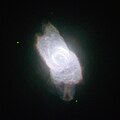Datoteka:NGC 6572.jpg
NGC_6572.jpg (500 × 500 piksela, veličina datoteke: 135 KB, MIME tip: image/jpeg)
Povijest datoteke
Kliknite na datum/vrijeme kako biste vidjeli datoteku kakva je tada bila.
| Datum/Vrijeme | Minijatura | Dimenzije | Suradnik | Komentar | |
|---|---|---|---|---|---|
| sadašnja | 19:08, 14. prosinca 2010. |  | 500 × 500 (135 KB) | Antonsusi | Better jpg-quality, less environment of no interest |
| 16:59, 13. prosinca 2010. |  | 629 × 638 (68 KB) | Jmencisom | {{Information |Description={{en|1=The NASA/ESA Hubble Space Telescope has turned its eagle eye to the planetary nebula NGC 6572, a very bright example of these strange but beautiful objects. Planetary nebulae are created during the late stages of the evol |
Uporaba datoteke
Na ovu sliku vode poveznice sa sljedećih stranica:
Globalna uporaba datoteke
Sljedeći wikiji rabe ovu datoteku:
- Uporaba na ar.wikipedia.org
- Uporaba na az.wikipedia.org
- Uporaba na be.wikipedia.org
- Uporaba na ce.wikipedia.org
- Uporaba na cs.wikipedia.org
- Uporaba na de.wikipedia.org
- Uporaba na diq.wikipedia.org
- Uporaba na en.wikipedia.org
- Uporaba na fa.wikipedia.org
- Uporaba na fr.wikipedia.org
- Uporaba na it.wikipedia.org
- Uporaba na it.wikibooks.org
- Uporaba na kk.wikipedia.org
- Uporaba na mk.wikipedia.org
- Uporaba na nl.wikipedia.org
- Uporaba na pl.wikipedia.org
- Uporaba na pt.wikipedia.org
- Uporaba na ru.wikipedia.org
- Uporaba na sk.wikipedia.org
- Uporaba na tr.wikipedia.org
- Uporaba na tt.wikipedia.org
- Uporaba na www.wikidata.org
- Uporaba na zh.wikipedia.org


